From “History of Trinity Congregation”
It is impossible to capture the past 120 years—the radiance, splendor, gray moments, hopeful horizons and vast multitude of emotions, ideals and frustrations. The following are reflections from some of those years.
On the nineteenth day of June 1870, this congregation was organized by The Reverend L. B. Leasure, with 48 charter members. Worship was held at first in the Wilkinsburg Academy, located on Wallace Avenue near Center Street. Later the Methodist church granted the use of their building to our congregation. After serving for a little over a year, the pastor resigned.
In July of 1871 a call was extended to The Reverend T. F. Stauffer, who began his pastorate on September 3. At once plans were made for the erection of a chapel. A lot valued at $3,000 was secured from Mr. James Kelly as a gift to the congregation. The lot extended from Franklin to Rebecca Avenues along Coal Street, 66 feet in depth. The corner stone of the chapel was laid October 15, 1811. During the winter the chapel was completed at a cost of $4,000 and dedicated June 5, 1872.
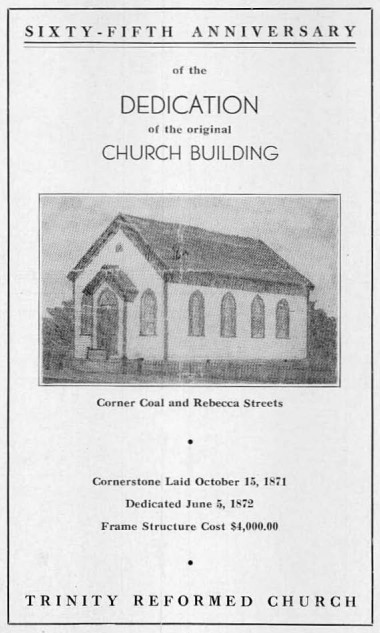
Wilkinsburg Public Library Digital Archives
On September 7, 1872 a petition for incorporation was filed and charter was granted on December 1, 1872. The six men who presented this matter were Samuel G. Lohr, George W. Cline, John Sperling, W. R. Watson, William Peterson and John McIntyre. The name of the corporation was “The Trinity Reformed Church of Wilkinsburg.”
In 1874 a parsonage was built on the Franklin Avenue end of the lot costing $2,800. Financial difficulties resulting from the panic of the previous year interfered with the paying of the indebtedness.
The pastorate of The Reverend J. M. Souder, beginning in April 1877, found the finances of the congregation in a serious condition. After laboring here for eighteen months, Rev. Souder resigned. It looked as though the congregation would disband. The sheriff threatened to sell the church. At this time Mrs. Margaretta Chadwick, who had previously loaned the congregation $1,200 came with generous hand and gave the note to the congregation. Later, Pittsburgh Synod gave $1,000 toward the indebtedness. It was then thought wise to sell the parsonage. It was sold at a sacrifice price of $1,600 (this being a time when property was at a discount owing to the hard times). The debt remained heavy and the sheriff’s threat hung like a pall over the church. It was then that four members of the congregation did a noble deed—they mortgaged their own property to save the church. These four men were Conrad Fix, John Sperling, John Swartz, and William Weitzel. This congregation owes these families, Mrs. Chadwick, and Pittsburgh Synod a debt ot gratitude.
The mission was now unable to support a pastor. Hence, they asked the pastor of Zion’s (St. Mark’s) Congregation in East Liberty to supply. This arrangement began in January 1879 with The Reverend J. W. Knappenberger being the supply pastor. Services were held Sunday afternoons. The loyal people were satisfied and worked hard to payoff the mortgage. The inspiration of this movement was Elder William Weitzel. He devoted much time and energy to managing the finances and remained treasurer for over thirty years. Rev. Knappenberger ended his supply pastorate in the fall of 1883.
In May 1884, The Reverend M. F. Frank became the supply pastor and continued until January 1886, leaving because of ill health. Thus for seven years the mission was supplied from Zion Church and the people remained true and faithful. Although at this time there were only 60 members, they had determination which is a very essential requirement in the forming of a mission. The debt was paid, the property saved and the organization maintained.
From J. B. S. in The Reformed Church Messenger, April 1, 1886
Sunday, March 28th, I spent with our mission at Wilkinsburg, just outside the city limits. The weather was “just awful,” but the neat little chapel was well filled, and in the evening the house was almost full. Wilkinsburg is destined in the near future, to become one of the most lovely parts of Pittsburgh. Nearly all the inhabitants of the town are engaged in the city and the thirty-five daily trains running between the town and the city, show the importance of the place now, and give an earnest of what it will be. The members of the mission are just such material out of which strong self-sustaining congregations grow. They have been sorely tried, and have risen above the threatening waves each time. They have a determination—back-bone—a very essential element in material for a mission. They have intelligence. While none are wealthy, yet nearly all own houses. Nearly all are young, and the Sunday School has more vigor and vim than many of our older charges.
No wonder the Board of Missions has taken this mission under special consideration. They are wise in doing so, as money spent for this interest is surely “Bread cast upon the waters.”
If Bro. Frank’s health could have enabled him to remain, and could he have devoted all his time to Wilkinsburg, in five years from now, they would have had a handsome church and been self-sustaining. What they now need is an active, able, energetic pastor, to whom they and the Board are willing to pay a good salary. A poor pastor would be more injurious than being vacant, as they can conduct very desirable and profitable services themselves.
You would travel a good ways before you would come across better men than Brothers Cline, Weizel, Fix, Sperling, George, Price, Fisher, Richmond, Smith. Brinker, and their good wives, and blooming daughters, and noble sons. Nothing could afford me more pleasure than to labor among these people, but to damage a charge by leaving it in order to serve another, would be even worse than “robbing Peter to pay Paul.”
But let me recommend this mission to any warm, enthusiastic pastor who might change fields with profit to himself and people, or to a student who desires a field where active work will tell.
From “History of Trinity Congregation”
The Mission was now ready for a full-time pastor. The Reverend James S. Freeman, a recent graduate of the Theological Seminary was called to the pastorate. He began his work in November 1886, and the membership increased to 148. The congregation grew, not rapidly, but substantially. In 1892 the Mission became self-supporting. For over twenty years the Board of Missions had nurtured this congregation. During this time the following organizations formed: The Ladies Aid Society, The Missionary Society, The Brotherhood of Andrew and Philip, The Laymen’s Missionary Movement, and the Christian Endeavor. Rev. Freeman’s pastorate continued until 1895.
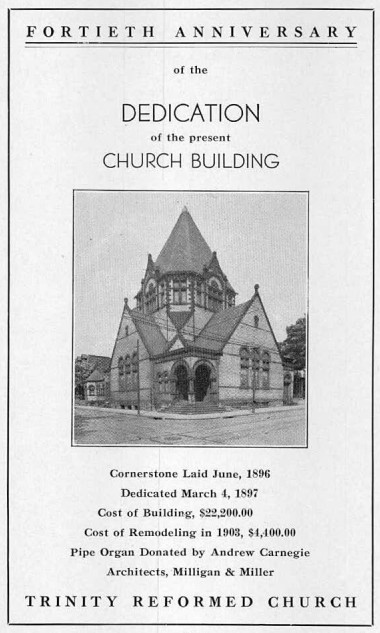
Wilkinsburg Public Library Digital Archives
In September 1895 a recent graduate of Tiffin Seminary, The Reverend C. L. Alspach, was selected as pastor. Wilkinsburg had now become a suburb of Pittsburgh. Many people sought it as a place of residence. The “Little Dutch Church,” as it was familiarly called, had become too small for the growing congregation. The people were compelled to build. The pastor proved to be an inspiring leader in this movement. In less than a year plans were completed and the corner stone of the new church was laid in June 1896. During the winter the building was completed and it was dedicated March 14, 1897. The cost of the church was $22,200. Mr. J. O. Brooke, a member of the church and a close friend of Andrew Carnegie, was successful in having a pipe organ (valued at $3,000) given to our church as a gift from Mr. Carnegie. The indebtedness was assumed, to be paid in five years. However, the failure to provide for the interest, the removal of some members, and other causes left the debt at $9,000 at the close of the five years. During his four and a half years pastorate the membership grew to 280. In April 1900, Rev. Alspach resigned the pastorate.
The Reverend Paul S. Leinbach was called to the pastorate and began his work October 1, 1900. During his pastorate of four years and two months the membership grew to 437. In 1902 a new parsonage was built at 1028 South Avenue, costing $7,300—with the understanding that the pastor pay the interest and taxes in lieu of rent. In 1903 the auditorium was remodeled and refrescoed at a cost of $4,400. The debt was now $10,000. In October 1904 individual members assumed the debt, to be paid in three years. It was not all paid, however, with the balance of the debt being $3,150. Rev. Leinbach’s pastorate closed December I, 1904.
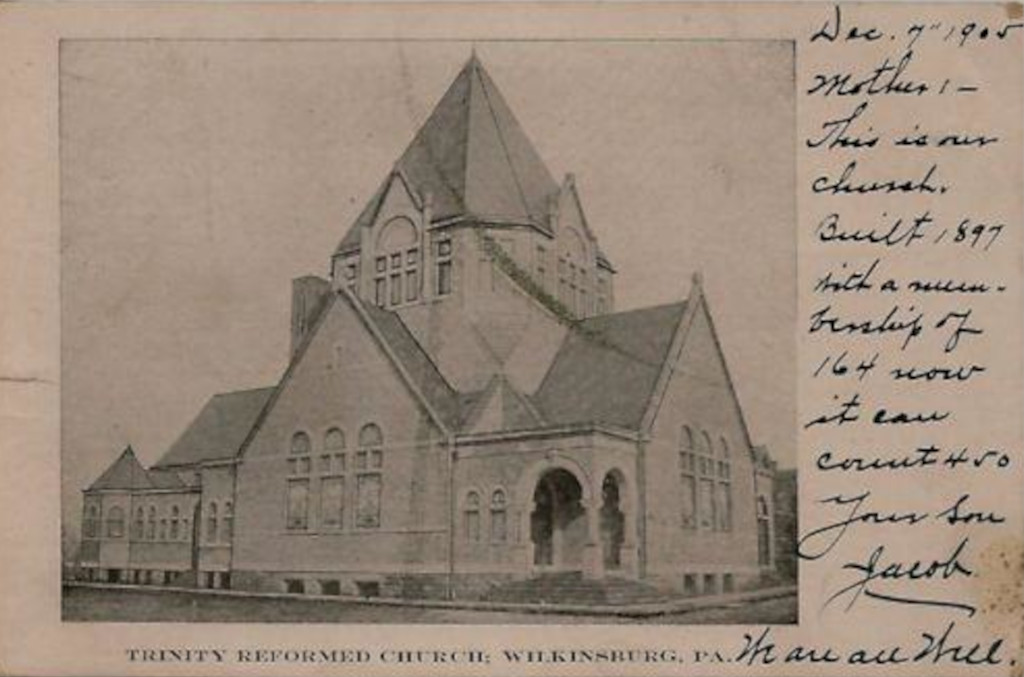
In March 1905, The Reverend Lewis Robb began his work at Trinity. In 1906 the South Avenue parsonage was sold and property next to the church at 907 Rebecca Avenue was bought at a financial advantage to the congregation. During this pastorate the congregation made great strides. All indebtedness was paid off and at the same time the church property was improved at a cost of $5,300. The membership grew to 711. Dr. Robb served the congregation until July 1, 1919 when he resigned due to ill health. Because he was so deeply loved, the honor of “Pastor Emeritus” was conferred on Dr. Robb by the congregation.
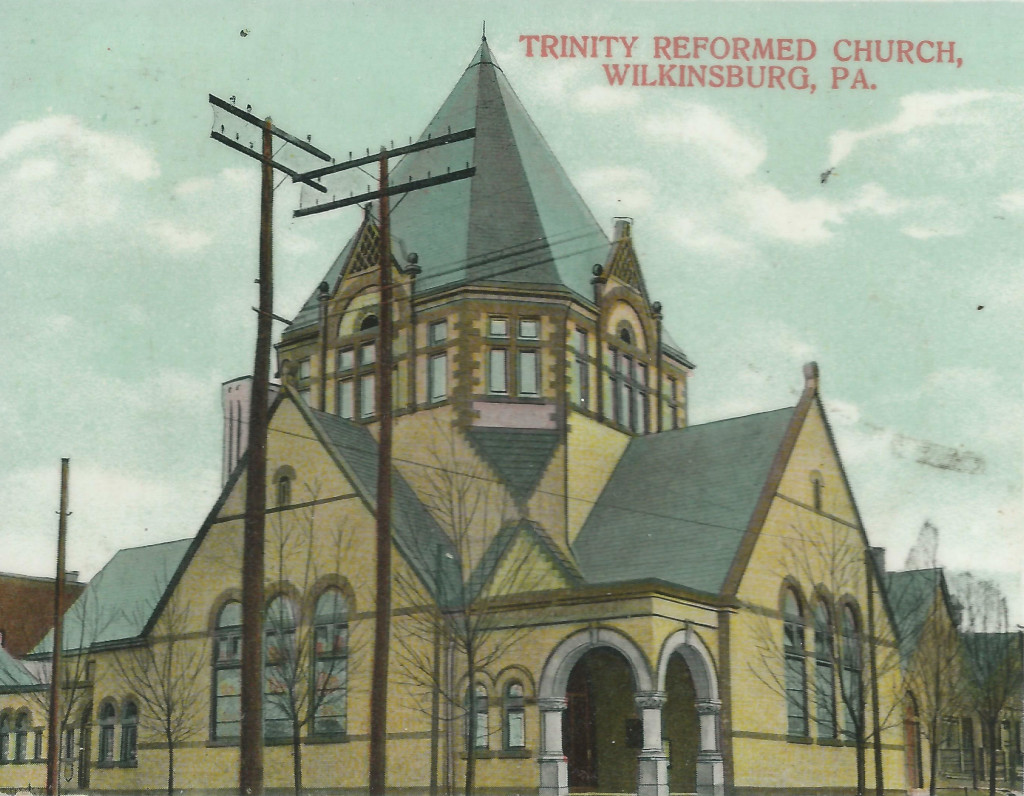
After World War I Trinity called an Army Chaplain, The Reverend Harry N. Bassler to Trinity on September 1, 1919. “Trinity News,” a monthly publication, was started in November 1919. Young men of the church organized the Friendship Club on April 15, 1920. In April 1923 the pastor moved from the parsonage at 907 Rebecca Avenue, to a rented apartment at 823 Franklin Avenue, in order that the parsonage could be equipped for the use of the Beginners and Primary Departments of the Sunday School. It became known as the Sunday School Annex.
In 1927 the Friendship Club undertook the organization of a Boy Scout unit at Trinity which resulted in the granting of a charter by Scout National Headquarters. The charter was presented at the Sunday morning church service on April 15, 1928. A new troop of nine boys became Troop 16 of the East Boroughs Council of the Boy Scouts of America.
In May 1929 the congregation authorized the purchase of property at 909 Rebecca Avenue, next to the Sunday School Annex. It was considered advisable to have this lot available in connection with future building plans. During the pastorate of Dr. Bassler, the church grew in scope and vitality. In 1929 Dr. Bassler resigned and preached his farewell sermon on Sunday, January 12, 1930.
The Reverend E. Roy Corman began his pastorate on March 26, 1930 at a time when the Depression was a grave concern, financially and spiritually, to our church. The parsonage was at 909 Rebecca Avenue. An Education Committee was established on September 9, 1930 to formulate plans and policies for our Church School program. In January 1931 the organ was electrified. The Communicant membership on April 1, 1931 was 775. On January 1, 1932 the Consistory of Trinity was reorganized into the following committees: Worship, Education, Evangelism, Missions, Stewardship, Social Service, Property and Publicity. A temporary building was built at the rear of the Sunday School Annex in September 1933. This building known as the Young Peoples Annex (”tin building”), provided a much needed space to encourage young people to attend our Church School. In 1936 the church sanctuary was redecorated, and new heating and lighting equipment was installed. This project was financed by the Ladies Aid Society. Services were held in September 1937 to celebrate the “Fortieth Anniversary” of the dedication of the present church building.
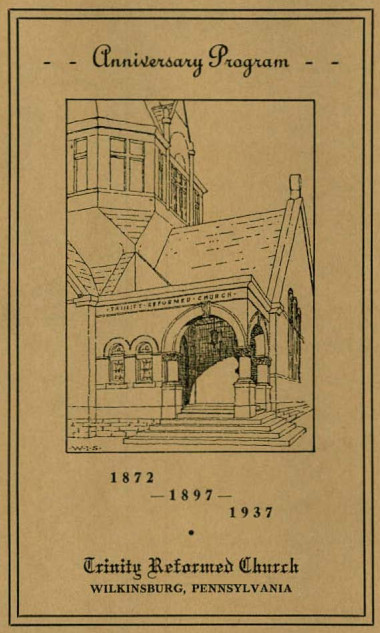
On December 15, 1940 the new stained glass windows were dedicated.
After the merger of the Evangelical and Reformed Churches, the name of the church was changed from Trinity Reformed to “Trinity Evangelical and Reformed Church” on November 20, 1940. The Women’s Guild was organized on December 4, 1941—uniting all the work of the women’s groups for the purpose of carrying out a larger program. The War of the forties called from our midst 119 of Trinity’s young people. The “75th Anniversary” was celebrated in 1945. Under the leadership of Dr. and Mrs. Corman our youth program grew substantially and the Church School provided exemplary leadership and training in Christian Education. Due to this growth, plans were undertaken to build a new educational wing at a cost of $152,000. The building was dedicated on June 24, 1956. In 1957 another denominational merger brought the congregation into the United Church of Christ. Dr. Corman served devotedly for many years as President of the Board of St. Paul Homes. He retired from the pastorate on June 1, 1958 and later was honored by Trinity with the title of “Pastor Emeritus.”

The Reverend G. Robert Booth began his ministry at Trinity on March 1, 1959. The new parsonage in Forest Hills was dedicated on January 8. 1961. Rev. Booth served for many years on the Board of St. Paul Homes and also on various denominational and community committees. The average membership during his pastorate was approximately 458. We began our “Advent Wreath” celebrations in 1960, and acolytes also became a part of our worship. Cub Scouts. Boy Scouts, Girl Scouts and the American Association of Retired Persons (AARP) were some of the very active groups meeting at Trinity. Much of the pastor’s work was devoted to pastoral counseling with visits to homes and hospitals. The Booths’ enthusiasm for Youth Fellowship and Youth Retreats were highlights for many lives. During these years there was strong worship support from Senior, Junior and Youth Choirs.

Trinity’s “100th Anniversary” was celebrated in June of 1970. Due to the generosity, dedication and commitment of numerous members the “early retirement of the church debt” was reported in the 1970 Annual Congregational Report. Rev. Booth left Trinity on January 10, 1971 in response to a call to a U.C.C. church in Zelienople. Pennsylvania. He left us with the following words: “If the future Church is to be a small group of people consecrated to Jesus Christ, sensitive to human need and humble enough to require a worship experience on the Lord’s Day, then Trinity offers a model community of believers. There is consecration here. There is sensitivity to human need here. There is a devoted core of humble people worshiping in the sanctuary on the Lord’s Day. For this, may the Lord be praised.“
As our country’s population continued to shift from urban areas to the suburbs, Trinity’s membership mirrored society. A call was extended to The Reverend Stephen J. Davidson to come to Trinity, on November 14. 1971, from the Union Church in Puerto Rico. Rev. Davidson’s experience in working with urban congregations was sought to strengthen our 1971 membership roster of 379. During his ministry many programs were developed to bring back inactive members and retain active members. Some of the programs and projects were: the continuation of a strong Women’s Guild, organization of a young adult group with significant adult programming, offering youth and adult retreats, a solid youth ministry, an informative newsletter and our first pictorial church directory. In addition. Trinity participated in “All Together Now” (a group program sponsored by community churches for over 400 children of the community). Rev. Davidson’s talent and interest in youth programming was recognized by a Summer Directorship at Camp Living Waters and the responsibility of organizing a Youth Task Force for Penn West Conference. The on-going ministry to youth, and meaningful and creative worship experiences guided by the Davidsons brought a spirit of joy to Trinity. The church name was changed in January 1974 to “Trinity Reformed United Church of Christ.” Rev. Davidson’s pastorate at Trinity continued until September 28, 1974 at which time he accepted a call to a U.C.C. congregation in Baltimore, Maryland.
The Reverend E. Leon Willhite began his pastorate on January 26, 1975. Rev. Willhite represented Trinity at local, Association, and Conference meetings and was a member of the Penn West Conference Board of Directors. The Willhites’ ministry encouraged us to progress in our relationships to the Wider Church. The German Reformed Church celebrated its “250th Anniversary” on October 15, 1978. During this pastorate the church was painted both inside and outside. The youth people collected money for the Children’s Hospital Drive and also began to assist in the Advent worship services. The monthly church newsletter continued and communication was further enhanced through pastoral calls and the endeavors of the church calling committees. Rev. Willhite shared the following message with members of Trinity: “Be a faithful witness wherever you are, and others will want to share your enthusiasm.” His pastorate continued until May 1, 1981 when he responded to a call from a U.C.C. church in Clinton, Iowa.
Dr. Richard Schiemann was called to Trinity on March 2, 1983. Dr. Schiemann’s main priority was “to bear witness to the oneness of the body of Christ.” In order to fulfill this commitment, Dr. Schiemann became extensively involved in community and church activities such as Meals on Wheels, Bethlehem Haven, The Penn West Conference (as a U.C.C. Representative to the United Campus Ministry Board), and The Pittsburgh Association (on the Youth Adult Task Force/Steering Committee). In addition, Dr. Schiemann brought growth to Trinity with 40 new members joining the congregation during 1985. This growth was due in part to his commitment to counseling and ministering to the congregation. The newsletter “TRUCC Lines” was regularly sent to members and friends of Trinity. During this period Trinity reached out to Narcotics Anonymous by providing them a meeting place. Worship services were given a new dimension when members began to serve as co-liturgists for worship. The Schiemanns provided Christian love and warmth to all people associated with Trinity. Their ministry at Trinity was concluded on December 31, 1986 when they accepted a call to Spencerport. New York.
The Reverend E. Ray Emerson began his pastorate on September 13, 1987. During his ministry Trinity hired a Student Intern, Patricia Williams, from Pittsburgh Theological Seminary to work with young people and youth activities. Activities during this pastorate included: a community youth center called “The TRUCC STOP,” re-activation of Girl Scout activities, Boy Scout Troop work, revitalization of the acolyte program, continuation of regular meetings of Narcotics Anonymous and also continuing support of the Wilkinsburg Community Ministry. Rev. Emerson served as advisor for Students Against Drunk Driving (SADD) with the Police Athletic League. Rev. Emerson’s pastorate continued until July 19, 1988 when he accepted a call to a U.C.C. congregation in Harrison City, Pennsylvania.
Sincere gratitude and appreciation along with Christian love is expressed to those pastors who have supplied our pulpit and served Trinity during various vacancies—Mr. Edgar J. Lewis, Dr. Robert S. Paul, Mr. Wayne Kemerer, The Reverend Patricia Williams and Mr. Kenneth G. Miller.
As we have reflected over the past 120 years, Trinity has experienced the radiance, splendor. gray moments, hopeful horizons, and vast multitude of emotions. ideals and frustrations of being the body of Christ. Times have changed, and in order to continue our Christian ministry and life as an extended family, we have reached out to Mt. Hope Community Church, Penn Hills. In the words of our new pastor, The Reverend Jay A. Collins: “In a world in which many things seem to be coming apart, we joyfully acknowledge and celebrate the coming together of Trinity Reformed United Church of Christ and Mt. Hope Community Church, United Presbyterian. We believe the God whose plan and purpose is to unite all things in heaven and on earth in Jesus Christ has led us to this time and place. We believe further, that this merger, necessitated by the declining membership ot Trinity Church, will be of mutual encouragement and benefit to our congregations and will enable us to more effectively engage In ministry and mission for the sake of Christ.”

Arc of the Covenant Church
Arc Ministry Inc acquired the church building in September 1990. The church ownership changed to Arc of the Covenant Church in April 2019.
Arc of the Covenant is a UHCA church, United Holy Church of America.
______
Wilkinsburg Public Library Digital Archives:
“History of Trinity Congregation.“J. B. S., Shippensburg, Pa., an Excerpt from The Reformed Church Messenger, April 1, 1886” in “Anniversary Program, 1872—1897—1937, Trinity Reformed Church.”